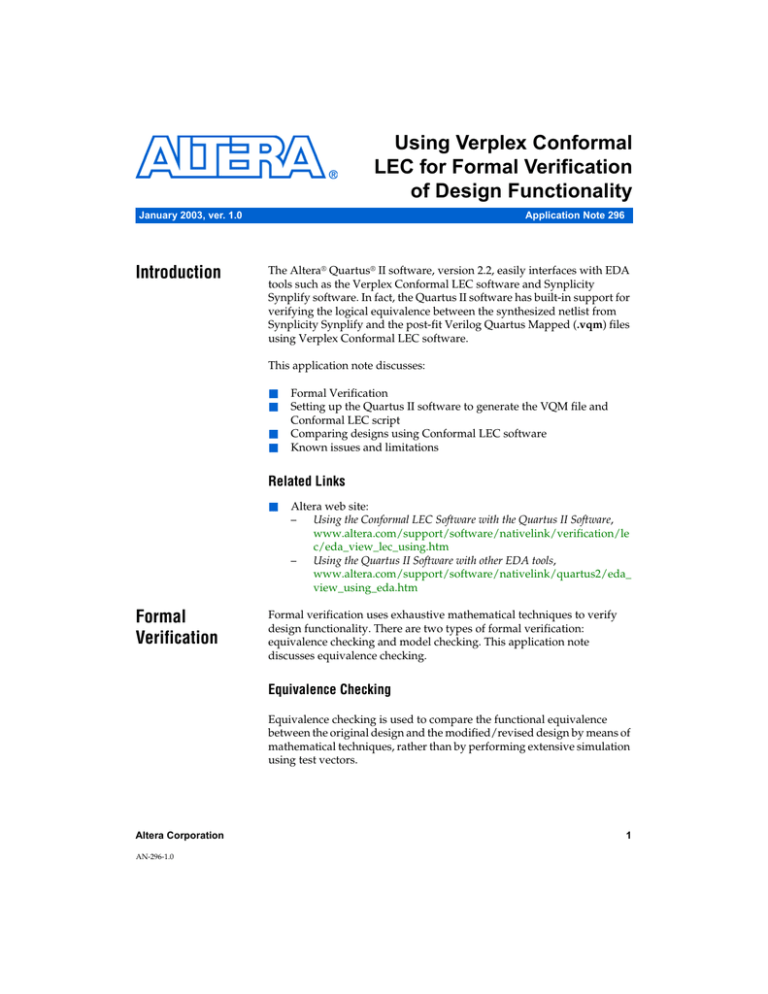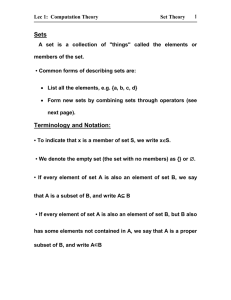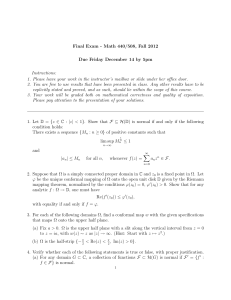
Using Verplex Conformal
LEC for Formal Verification
of Design Functionality
January 2003, ver. 1.0
Introduction
Application Note 296
The Altera® Quartus® II software, version 2.2, easily interfaces with EDA
tools such as the Verplex Conformal LEC software and Synplicity
Synplify software. In fact, the Quartus II software has built-in support for
verifying the logical equivalence between the synthesized netlist from
Synplicity Synplify and the post-fit Verilog Quartus Mapped (.vqm) files
using Verplex Conformal LEC software.
This application note discusses:
■
■
■
■
Formal Verification
Setting up the Quartus II software to generate the VQM file and
Conformal LEC script
Comparing designs using Conformal LEC software
Known issues and limitations
Related Links
■
Formal
Verification
Altera web site:
–
Using the Conformal LEC Software with the Quartus II Software,
www.altera.com/support/software/nativelink/verification/le
c/eda_view_lec_using.htm
–
Using the Quartus II Software with other EDA tools,
www.altera.com/support/software/nativelink/quartus2/eda_
view_using_eda.htm
Formal verification uses exhaustive mathematical techniques to verify
design functionality. There are two types of formal verification:
equivalence checking and model checking. This application note
discusses equivalence checking.
Equivalence Checking
Equivalence checking is used to compare the functional equivalence
between the original design and the modified/revised design by means of
mathematical techniques, rather than by performing extensive simulation
using test vectors.
Altera Corporation
AN-296-1.0
1
AN 296: Using Verplex Conformal LEC for Formal Verification of Design Functionality
Where to Apply Formal Verification?
Formal verification can be applied at every stage of the Altera FPGA
design flow. See Figure 1.
Figure 1. Altera FPGA Design Flow
RTL
Equivalence Checking
Synthesis
Synthesized
Netlist
Place & Route
Equivalence Checking
Place & Route
Netlist
Figure 2 shows the formal verification flow supported by Altera using
Synplicity Synplify and Conformal LEC software.
Figure 2. Formal Verification Flow Using Synplify & Conformal LEC Software
.vhd
.v
Synplicity Synplify
Software
.vqm
Golden Netlist
FPGA Library
Conformal LEC
Software
Quartus II Software
.vqm
2
Revised Netlist
Altera Corporation
AN 296: Using Verplex Conformal LEC for Formal Verification of Design Functionality
Setting Up the
Quartus II
Software to
Generate the
VQM File &
Conformal LEC
Script
The following steps describe how to set up the Quartus II software
environment to generate the place and route, post-fit VQM netlist file and
Conformal LEC script compatible for formal verification.
1.
If you have not done so, create a new project or open an existing
project.
2.
Choose EDA Tools Settings (Assignments menu)
3.
Select Design entry/synthesis in the EDA tools list, and scroll to
Synplify in the Tool name pull-down list (Tool settings window).
Next, select Formal verification in the EDA tools list, and scroll to
Verplex Conformal LEC in the Tool name pull-down list (Tool
settings window). See Figure 3.
1
The Quartus II software allows up to six EDA tools to be
selected in the EDA tools list.
Figure 3. EDA Tools Selection
Altera Corporation
3
AN 296: Using Verplex Conformal LEC for Formal Verification of Design Functionality
4.
Click OK.
5.
Select Start (Processing menu), and choose Start >Analysis &
Elaboration from the pop-up window.
If your project includes any of the following, the synthesized VQM
netlist file from Synplify contains black boxes:
–
–
–
6.
Altera library of parameterized modules (LPM’s) components
Encrypted intellectual property (IP) cores
Entities that are defined in the design format other than Verilog
HDL, VHDL, or EDIF
If your project does not contain any black boxes in the VQM netlist
file, skip to Step 7.
The hierarchy boundaries of the VQM netlist black boxes need to be
preserved. To do so, set the Preserve Hierarchical Boundary option
to Firm by performing the following steps:
a.
Identify the black boxes from the Hierarchies window by
expanding the top level design folder (click on the + sign next to
the module name) as shown in the Figure 4.
b.
Once the black box (altsyncram, in the Figure 4 example) is
identified, right-click on the black box and select Assignment
Organizer in the pop-up window.
At this point, the option Preserve Hierarchical Boundary is set
on the altsyncram entity and not on the Synplicity_altsyncram
module that instantiates.
4
Altera Corporation
AN 296: Using Verplex Conformal LEC for Formal Verification of Design Functionality
Figure 4. Identifying Synthesized VQM Netlist File Black Boxes & Preserving the Hierarchical Boundary
Altera Corporation
c.
Expand the Options for Entities Only folder in the Assignment
Categories window and choose Click here to add a new
assignment. See Figure 5.
d.
Scroll to Preserve Hierarchical Boundary in the Assignment
Name window and Firm in the Assignment Setting window.
e.
Click Add.
f.
Check the All instances of this entity (n/a for individual nodes)
box in the Stored in assignments for window.
g.
Click OK to close the window.
h.
Repeat steps a through g for all black boxes in the design.
5
AN 296: Using Verplex Conformal LEC for Formal Verification of Design Functionality
Figure 5. Assignment Organizer Window
6
7.
Choose Settings (Assignments menu).
8.
In the Settings dialog box, expand the Compiler Settings folder
(Category window) and select Netlist Optimizations.
9.
In the Synthesis optimizations window, ensure that both the Perform
WYSIWYG primitive resynthesis (using technology mapper
specified in default logic option settings) and Perform gate-level
register retiming options are unchecked. Ensure also that both the
Automatically duplicate logic elements and Perform logic element
level LUT resynthesis options in the Fitter optimizations window
are not checked. See Figure 6.
Altera Corporation
AN 296: Using Verplex Conformal LEC for Formal Verification of Design Functionality
Figure 6. Setting Parameters for Netlist Optimizations
1
Retiming on a design usually results in moving and merging
registers along the critical path. Because equivalence checkers
compare the cones of logic terminating at registers, it is necessary
that the registers not be moved, or duplicated, during Quartus II
optimization. If the options in this section are not selected, the
LEC script could be presented with a different set of compare
points, and the resulting netlist will be difficult to compare
against the reference netlist file.
10. Perform full compilation of the design either by selecting Start
Compilation (Processing menu) or by clicking the start compilation
arrow icon located in the tool bar.
Altera Corporation
7
AN 296: Using Verplex Conformal LEC for Formal Verification of Design Functionality
The Quartus II software compiler generates:
■
■
VQM file: <design_name>.vqm
Script file: <design_name>.vlc to be used with Conformal LEC
software
■ A black box file: <design_name>_bbox.v that contains all the user
defined black box entities in the design at:
/<project directory>/fv/clec directory
The <design_name>_bbox.v file contains the module description of only
those entities that are not defined in the formal verification library. For
example if there is a reference to black box altdpram in the design, the
<design_name>_bbox.v files does not contain the module description for
altdpram as it is defined in the mfs_bbox.v file of the formal verification
library.
Comparing
Designs Using
Conformal LEC
Software
This section discusses using Conformal LEC software to compare designs.
Black Boxes in the Conformal LEC Flow
A module has to be treated as a black box if the corresponding Conformal
LEC formal verification model is not available. As discussed in the
“Setting Up the Quartus II Software to Generate the VQM File &
Conformal LEC Script” on page 3, the synthesized VQM netlist from
Synplify contains black boxes if your project includes any of the following:
■
■
■
LPM components
Encrypted IP cores
Entities that are defined in design format other than Verilog HDL,
VHDL, or EDIF
Although every LPM component is treated as a black box by Synplify, if a
corresponding Conformal LEC verification model exists, the LPM
component is replaced by logic cells in the Quartus II software-generated
VQM netlist file. For example, if the design has references to LPM_MULT
and LPM_ROM, only LPM_ROM is treated as a black box because the
corresponding Conformal LEC verification model is not available. The
LPM_MULT is replaced by logic cells in the Quartus II software-generated
VQM netlist file.
8
Altera Corporation
AN 296: Using Verplex Conformal LEC for Formal Verification of Design Functionality
1
VQM netlist files written by the Quartus II software contain the
black box hierarchy when the assignment name Preserve
Hierarchical Boundary is set to Firm (see Figure 5) on a black
box and VERPLEX CONFORMAL LEC is selected as the Formal
verification tool (see Figure 3). If the Preserve Hierarchical
Boundary is not set to Firm on the black box, the Quartus II
software replaces the black box with logic cells and the VQM
netlist file no longer contains the black box hierarchy or
preserves the port interface, which results in a mismatch with
Conformal LEC software.
Using Conformal LEC Software
Conformal LEC software can be used to verify the VQM netlists generated
by Synplify and the Quartus II software either from the command line or
from the graphical user interface (GUI) using the <design_name>.vlc script
file generated by the Quartus II software.
Using Conformal LEC Software from the Command Line
Type the following at the command prompt:
%lec -dofile /<path to project
directory>/fv/clec/<design_name>.vlc -nogui
Using Conformal LEC Software from the GUI
Invoke Conformal LEC software using the command LEC from within the
GUI.
Select Do Dofile (File menu) and select /<path to project
directory>/fv/clec/<design_name>.vlc file.
Conformal LEC software performs functional comparisons between the
VQM netlist files, and then outputs the result as shown in Figure 7.
Altera Corporation
9
AN 296: Using Verplex Conformal LEC for Formal Verification of Design Functionality
Figure 7. Conformal LEC Software GUI
The Conformal LEC software shows the original VQM netlist in the
Golden window and the Quartus II generated VQM netlist in the Revised
window (see Figure 7). The status section at the bottom of the ConformalLEC window reports the results of the verification, including the number
of compared DFFs and POs (Primary Outputs), as well as the number of
DFFs and POs that are equivalent and non-equivalent respectively.
To investigate the results of the verification click the Mapping Manager
icon in the toolbar, or choose Mapping Manager (Tools menu). The
Conformal LEC software reports the mapped, unmapped, and compared
points in the Mapped Points, Unmapped Points, and Compared Points
windows respectively.
1
10
For more information on how to diagnose the non-equivalent
points, refer to the Conformal LEC user manual.
Altera Corporation
AN 296: Using Verplex Conformal LEC for Formal Verification of Design Functionality
Known Issues
& Limitations
This section discusses known issues and limitations with the formal
verification flow using Synplify software, the Quartus II software, and
Conformal LEC software:
■
■
■
■
■
■
Altera Corporation
Formal verification flow supports the APEX™ 20KE, APEX 20KC,
APEX II, Cyclone™, Stratix™, and Stratix GX device families.
Formal verification between RTL and Synplify-generated VQM files
for Altera devices is not supported.
Because the Quartus II software does not preserve the port names in
the user-defined black box entities where the resulting entity is
synthesized as a wire in the output netlist, black boxes containing
logic that can be reduced to a wire in the revised netlist should be
ignored in the Golden netlist.
–
For example a black box defined as:
module black_box (in,out);
input in;
output out;
endmodule
–
And the actual implementation represented by:
module black_box (in,out);
input in;
output out;
assign out = in;
endmodule
–
At this point, the Quartus II software replaces the black box with
a wire because there is no logic inside the module.
Unused logic optimized within the black box by the Quartus II
software might result in an interface different from the synthesized
VQM netlist.
In designs with combinational feedback loops, the Conformal LEC
software may incorrectly insert extra, unmapped cut points in the
revised netlist.
When multiple ports on a black box entity are driven by the same
signal, the Quartus II software will push the connections into the
entity, and use a single port to drive the internal logic. This action
results in the remaining ports being unconnected on the black box
entity in the revised netlist. See Figure 8.
11
AN 296: Using Verplex Conformal LEC for Formal Verification of Design Functionality
Figure 8. Quartus II Software Consolidates Duplicate Ports into a Single Port to Drive Internal Logic
Black Box Ports Before Quartus II Software
Pushes the Connections Into the Entity
Black Box Ports After Quartus II Software
Pushes the Connections Into the Entity
z
rd_addr
wr_addr
rd/wr_addr
wr_en
rd_en
rd_addr
rd_logic
wr_logic
rd/wr_addr
wr_en
rd_en
data
data
■
■
12
Because of incorrect capitalization of port names in the revised netlist
file, designs with the lpm_dff megafunction may produce
mismatches on the entity and port names. Manually edit the Golden
netlist to correct the port names:
–
For example, if the Synplify VQM netlist contains an LPM_DFF
module:
- LPM_DFF U1 (
- .Q(Q),
- .DATA(DATA),
- .CLOCK(CLOCK),
- .ASET(ASET),
- .ACLR(ACLR)
- );
- defparam U1.LPM_WIDTH = 1;
- defparam U1.WIDTH = 1;
- defparam U1.LPM_TYPE = "LPM_DFF";
–
Edit the file to replace the description:
- lpm_dff U1 (
- .Q(Q),
- .DATA(DATA),
- .CLOCK(CLOCK),
- .ASET(ASET),
- .ACLR(ACLR)
- );
- defparam U1.lpm_width = 1;
- defparam U1.width = 1;
- defparam U1.lpm_type = "LPM_DFF";
For Stratix designs that contain RAM blocks, optimization of the
RAM blocks in the Quartus II software results in the creation of new
port names. This causes Conformal LEC software to report
mismatches.
Altera Corporation
AN 296: Using Verplex Conformal LEC for Formal Verification of Design Functionality
■
■
■
The LEC software may list non-equivalent points on designs using
the lpm_mult megafunction, where the width of the product is less
than the sum of the widths of the inputs. This issue comes up because
the Quartus II software truncates the least significant bits in the width
of the product.
Because the Quartus II software uses a default width of 30 and the
LEC software uses a default value of one for the lpm_width
parameter, the LEC software may report non-equivalent points on
the width of the sum port with designs using the lpm_mult
megafunction when the sum port is not connected. This results in a
mismatch between the other 29 bits in the port width.
Quartus II software groups logic cells (from the Golden design) that
use only registers with logic cells that use only look-up-tables (LUTs),
and then packs the logic cells into single logic cells with both the
LUTs and the registers in the revised design—with an instance name
taken from the LUT-only logic cell in the Golden design. The LEC
software attempts to map the register-only logic cell name to an
incorrect logic cell in the revised design, resulting in a non-equivalent
point. Manually edit the mapping in the revised design to map to the
correct logic cell. See Figure 9.
Figure 9. Manually Edit Mapping
Golden Design
Conclusion
Altera Corporation
Logic Cell A
Logic Cell B
LUTs
Registers
Revised Design
Logic Cell A
LUTs
+
Registers
Formal verification enables verification of the design during all stages
from RTL to place and route. As designs become larger and larger,
verification of designs using traditional methods is too time consuming.
Thus, formal verification easily verifies that any modifications to the
netlist in the physical domain have not altered from the Golden netlist.
Advanced debugging capabilities within Conformal LEC software
pinpoints the source of the differences between the Golden and Revised
netlists, enabling the user to easily fix the differences.
13
AN 296: Using Verplex Conformal LEC for Formal Verification of Design Functionality
101 Innovation Drive
San Jose, CA 95134
(408) 544-7000
http://www.altera.com
Applications Hotline:
(800) 800-EPLD
Literature Services:
lit_req@altera.com
14
Copyright © 2003 Altera Corporation. All rights reserved. Altera, The Programmable Solutions Company, the
stylized Altera logo, specific device designations, and all other words and logos that are identified as
trademarks and/or service marks are, unless noted otherwise, the trademarks and service marks of Altera
Corporation in the U.S. and other countries. All other product or service names are the property of their
respective holders. Altera products are protected under numerous U.S. and foreign patents and pending
applications, mask work rights, and copyrights. Altera warrants performance of its
semiconductor products to current specifications in accordance with Altera’s standard
warranty, but reserves the right to make changes to any products and services at any time
without notice. Altera assumes no responsibility or liability arising out of the application
or use of any information, product, or service described herein except as expressly agreed
to in writing by Altera Corporation. Altera customers are advised to obtain the latest
version of device specifications before relying on any published information and before
placing orders for products or services.
Altera Corporation



